The AMD Ryzen Threadripper 1950X and 1920X Review: CPUs on Steroids
by Ian Cutress on August 10, 2017 9:00 AM ESTCPU Encoding Tests
One of the interesting elements on modern processors is encoding performance. This includes encryption/decryption, as well as video transcoding from one video format to another. In the encrypt/decrypt scenario, this remains pertinent to on-the-fly encryption of sensitive data - a process by which more modern devices are leaning to for software security. Video transcoding as a tool to adjust the quality, file size and resolution of a video file has boomed in recent years, such as providing the optimum video for devices before consumption, or for game streamers who are wanting to upload the output from their video camera in real-time. As we move into live 3D video, this task will only get more strenuous, and it turns out that the performance of certain algorithms is a function of the input/output of the content.
All of our benchmark results can also be found in our benchmark engine, Bench.
7-Zip 9.2: link
One of the freeware compression tools that offers good scaling performance between processors is 7-Zip. It runs under an open-source licence, is fast, and easy to use tool for power users. We run the benchmark mode via the command line for four loops and take the output score.

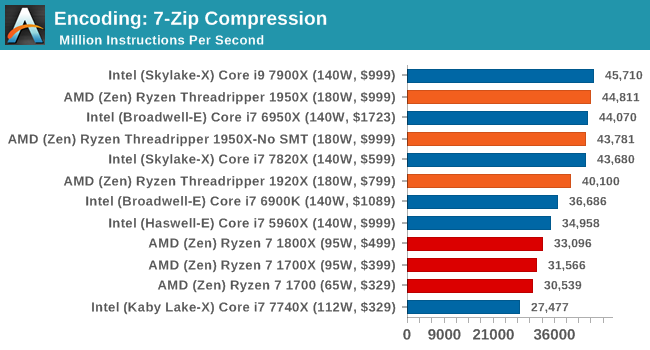
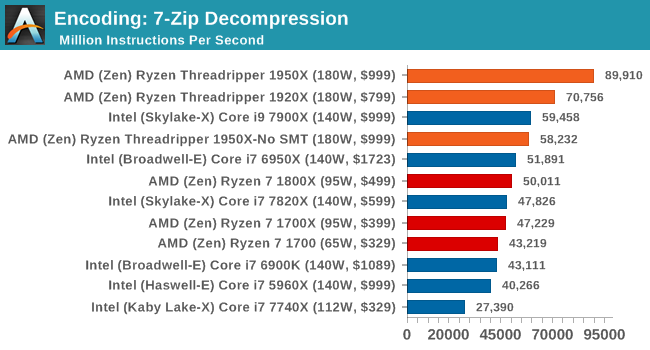
At the request of a few users, we've gone back through our saved benchmark data and pulled out compression/decompression numbers for 7-zip. AMD clearly makes a win here in decompression by a long way.
WinRAR 5.40: link
For the 2017 test suite, we move to the latest version of WinRAR in our compression test. WinRAR in some quarters is more user friendly that 7-Zip, hence its inclusion. Rather than use a benchmark mode as we did with 7-Zip, here we take a set of files representative of a generic stack (33 video files in 1.37 GB, 2834 smaller website files in 370 folders in 150 MB) of compressible and incompressible formats. The results shown are the time taken to encode the file. Due to DRAM caching, we run the test 10 times and take the average of the last five runs when the benchmark is in a steady state.
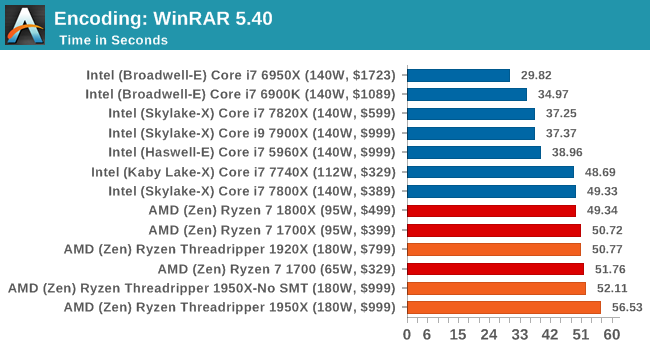
WinRAR encoding is another test that doesn't scale up especially well with thread counts. After only a few threads, most of its MT performance gains have been achieved. Which isn't a help to Threadripper, and is outright a hiderence in Creator Mode.
AES Encoding
Algorithms using AES coding have spread far and wide as a ubiquitous tool for encryption. Again, this is another CPU limited test, and modern CPUs have special AES pathways to accelerate their performance. We often see scaling in both frequency and cores with this benchmark. We use the latest version of TrueCrypt and run its benchmark mode over 1GB of in-DRAM data. Results shown are the GB/s average of encryption and decryption.
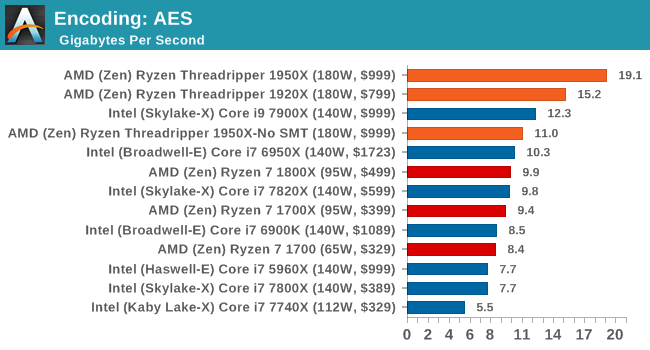
HandBrake v1.0.2 H264 and HEVC: link
As mentioned above, video transcoding (both encode and decode) is a hot topic in performance metrics as more and more content is being created. First consideration is the standard in which the video is encoded, which can be lossless or lossy, trade performance for file-size, trade quality for file-size, or all of the above can increase encoding rates to help accelerate decoding rates. Alongside Google's favorite codec, VP9, there are two others that are taking hold: H264, the older codec, is practically everywhere and is designed to be optimized for 1080p video, and HEVC (or H265) that is aimed to provide the same quality as H264 but at a lower file-size (or better quality for the same size). HEVC is important as 4K is streamed over the air, meaning less bits need to be transferred for the same quality content.
Handbrake is a favored tool for transcoding, and so our test regime takes care of three areas.
Low Quality/Resolution H264: Here we transcode a 640x266 H264 rip of a 2 hour film, and change the encoding from Main profile to High profile, using the very-fast preset.
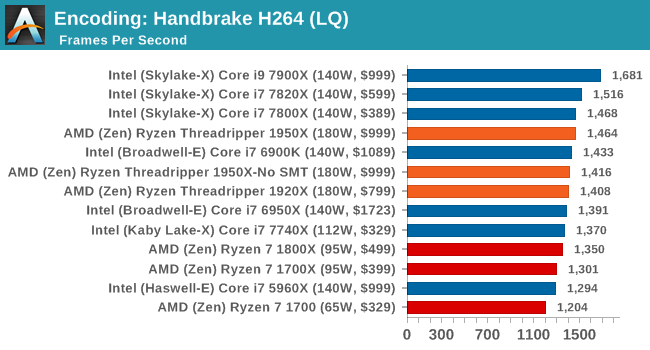
High Quality/Resolution H264: A similar test, but this time we take a ten-minute double 4K (3840x4320) file running at 60 Hz and transcode from Main to High, using the very-fast preset.
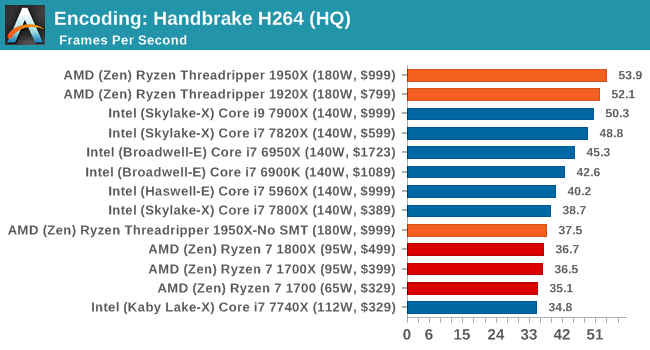
HEVC Test: Using the same video in HQ, we change the resolution and codec of the original video from 4K60 in H264 into 4K60 HEVC.
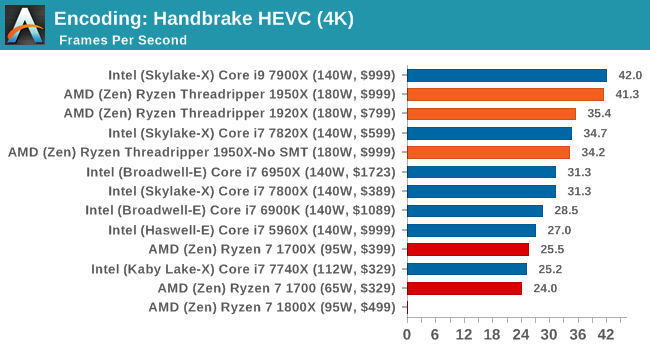
In the HQ H264 test, AMD pushes ahead with both the processors, while SMT-off severely limits the 1950X due to the lack of SMT threads. As we move to HEVC though, the 1950X and 7900X clash on performance.










347 Comments
View All Comments
NikosD - Sunday, August 13, 2017 - link
Well, reading the whole review today - 13/08/2017 - I can see that the reviewer did something more evil than not using DDR4-3200 to give us performance numbers.He used DDR4-2400, as he clearly states in the configuration table, filling up the performance tables BUT in the power consumption page he added DDR4-3200 results (!) just to inform us that DDR4-3200 consumes 13W more, without providing any performance numbers for that memory speed (!!)
The only thing left for the reviewer is to tell us in which department of Intel works exactly, because in the first pages he wanted to test TR against a 2P Intel system as Skylake-X has only 10C/20T but Intel didn't allow him.
Ask for your Intel department to permit it next time.
Zingam - Sunday, August 13, 2017 - link
Yeah! You make a great point! Too much emphasis on gaming all the time! These processors aren't GPUs after all! Most people who buy PCs don't play games at all. Even I as a game developer would like to see more real world tests, especially compilation and data-crunching tests that are typical for game content creation and development workloads. Even I as a game developer spend 99% of my time in front of the computer not playing any games.pm9819 - Friday, August 18, 2017 - link
So Intel made AMD release the underpowered overheating Bulldozer cpu's? Did Intel also make them sell there US and EU based fabs so they'll be wholly dependant on the Chinese to make their chips? Did Intel also make them buy a equally struggling graphics card company? Truth is AMD lost all the mind and market share they had because of bad corporate decision and uncompetitive cpu designs post Thunderbird. It's no one's fault but there own that it took seven years to produce a competitive replacement. Was Intel suppose to wait till they caught up? And Intel was a monopoly long before AMD started producing competitive cpu's.You can keep blaming Intel for AMD's screw ups but those of us with common sense and the ability to read know the fault lays with AMD's management.
ddriver - Thursday, August 10, 2017 - link
You are not sampled because of your divine objectivity Ian, you are sampled because you review for a site that is still somewhat popular for its former glory. You can deny it all you want, and understandable, as it is part of your job, but AT is heavily biased towards the rich american boys - intel, apple, nvidia... You are definitely subtle enough for the dumdums, but for better or worse, we are not all dumdums yet.But hey, it is not all that bad, after all, nowadays there are scores of websites running reviews, so people have a base for comparison, and extrapolate objective results for themselves.
ddriver - Thursday, August 10, 2017 - link
And some bits of constructive criticism - it would be nicer if those reviews featured more workloads people actually use in practice. Too much synthetics, too much short running tests, too much tests with software that is like "wtf is it and who in the world is using it".For example rendering - very few people in the industry actually use corona or blender, blender is used for modelling and texturing a lot, but not really for rendering. Neither is luxmark. Neither is povray, neither is CB.
Most people who render stuff nowadays use 3d max and vray, so testing this will actually be indicative of actual, practical perforamnce to more people than all those other tests combined.
Also, people want render times, not scores. That's very poor indication of actual performance that you will get, because many of those tests are short, so the CPU doesn't operate in the same mode it will operate if it sweats under continuous work.
Another rendering test that would benefit prosumers is after effects. A lot of people use after effects, all the time.
You also don't have a DAW test, something like cubase or studio one.
A lot of the target market for HEDT is also interested in multiphysics, for example ansys or comsol.
The compilation test you run, as already mentioned several times by different people, is not the most adequate either.
Basically, this review has very low informational value for people who are actually likely to purchase TR.
mapesdhs - Thursday, August 10, 2017 - link
AE would definitely be a good test for TR, it's something that can hammer an entire system, unlike games which only stress certain elements. I've seen AE renders grab 40GB RAM in seconds. A guy at Sony told me some of their renders can gobble 500GB of data just for a single frame, imposing astonishing I/O demands on their SAN and render nodes. Someone at a London movie company told me they use a 10GB/sec SAN to handle this sort of thing, and the issues surrounding memory access vs. cache vs. cores are very important, eg. their render management sw can disable cores where some types of render benefit from a larger slice of mem bw per core.There are all sorts of tasks which impose heavy I/O loads while also needing varying degrees of main CPU power. Some gobble enormous amounts of RAM, like ANSYS, though I don't know if that's still used.
I'd be interested to know how threaded Sparks in Flame/Smoke behave with TR, though I guess that won't happen unless Autodesk/HP sort out the platform support.
Ian.
Zingam - Sunday, August 13, 2017 - link
Good points!Notmyusualid - Sunday, August 13, 2017 - link
...only he WAS sampled. Read the review.bongey - Thursday, August 10, 2017 - link
You don't have to be paid by Intel, but this is just a bad review.Gothmoth - Thursday, August 10, 2017 - link
where is smoke there is fire.there are clear indications that anandtech is a bit biased.